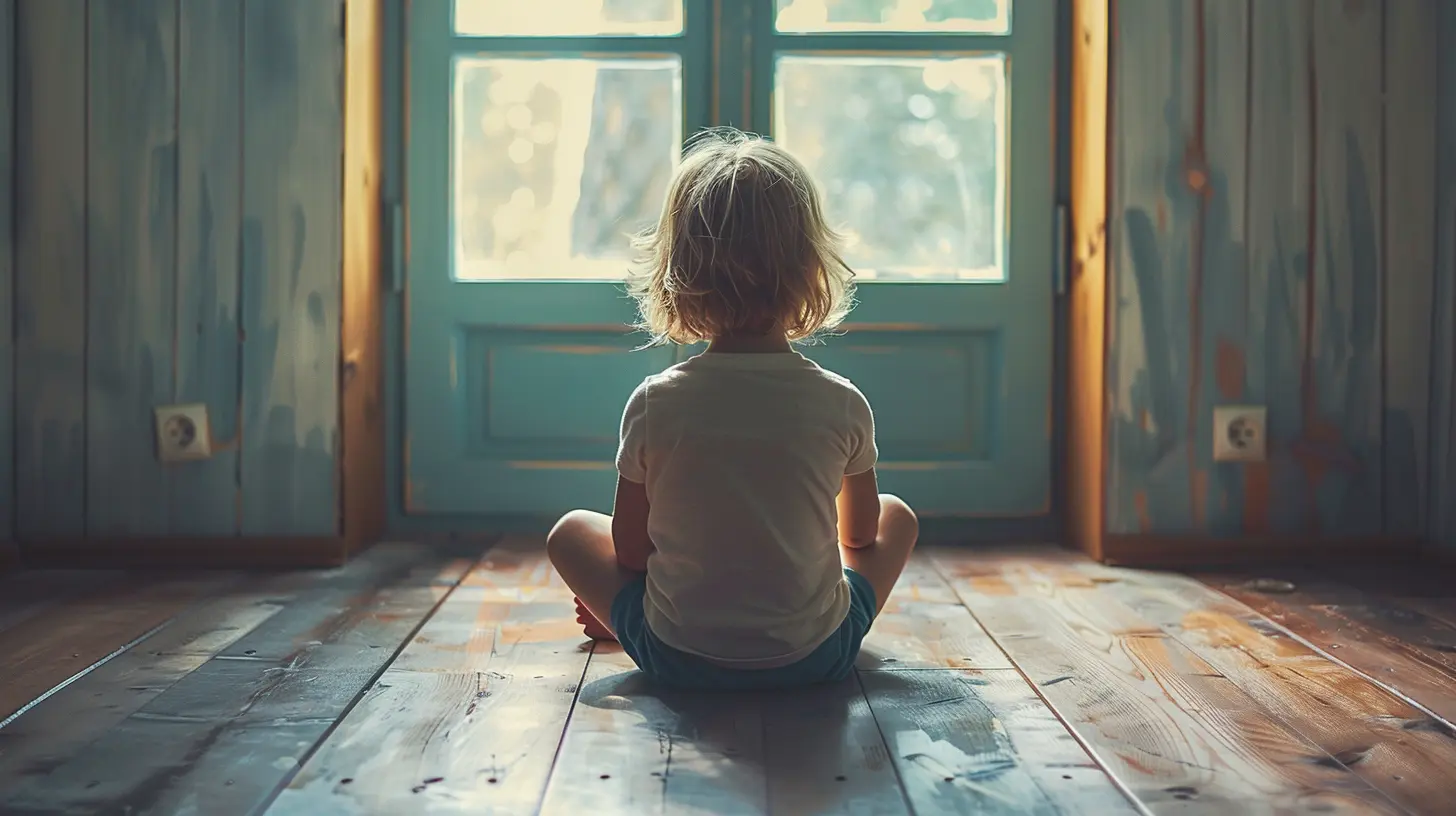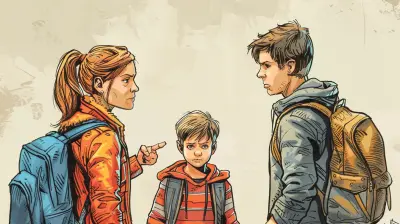How to Talk About Anxiety in Age-Appropriate Ways
9 October 2025
Anxiety—it's that sneaky little shadow that follows us around, sometimes whispering worries into our ears, other times screaming them at full volume. As adults, we barely have it all figured out, so how do we explain it to our kids?
The way we talk about anxiety matters. Whether your child is a preschooler who fears the dark or a teenager battling overwhelming pressure, they need reassurance and guidance. But here's the kicker—how we frame that conversation needs to shift based on their age.
So, let's break it down. How do we talk about anxiety in ways that actually help, without making it scarier than it already is? 
Understanding Anxiety: A Hidden Monster or a Helpful Alarm?
Anxiety isn't just a bad guy lurking in the shadows—it's actually a built-in alarm system designed to keep us safe. Imagine you're a caveman hearing a rustle in the bushes. Is it the wind, or is it a saber-toothed tiger ready to pounce? Your anxiety kicks in, making you alert and ready to react. Useful, right?But in today’s world, that alarm sometimes goes off when there’s no real danger—like before a test or a big presentation. Understanding this is key when talking to children about it. They need to know that anxiety isn’t a villain; it’s just a little overprotective sometimes. 
Talking to Toddlers and Preschoolers (Ages 2-5)
Keep It Simple and Relatable
Young kids don’t have the words (or the patience) for long-winded explanations. They live in a world of big emotions and tiny vocabularies. So how do we explain anxiety to them?- Use Stories and Characters – “Sometimes, our brain has a silly little alarm bell that rings when we don't need it to. It's like a puppy barking at a harmless balloon!”
- Reassure Them – Let them know it’s okay to feel scared, and that feelings come and go, just like clouds in the sky.
- Give It a Name – Little ones love to name things. Call anxiety "Mr. Worry" or "The Fluttery Butterfly" to make it feel less intimidating.
Examples of What to Say
- “I know you don’t want to sleep alone. Sometimes, our brain tells us scary stories at night, but we’re safe, and those stories aren’t real.”- “Your tummy feels funny because your worry alarm is going off. Let’s take deep breaths until it calms down.”

Helping Elementary-Aged Kids (Ages 6-11)
Make It Understandable Without Overwhelming
At this age, kids start to ask more “why” questions. They want logical reasons behind what they feel but still need reassurance. The trick? Finding the balance between science and simplicity.- Use Comparisons They Relate To – “Anxiety is like a smoke alarm that sometimes goes off when you burn toast instead of when there's a real fire.”
- Teach Coping Tools – Introduce breathing techniques, journaling, or even “talking back” to their worries.
- Normalize It – Let them know everyone feels anxious sometimes, even superheroes and grown-ups.
Examples of What to Say
- “Anxiety is like having a worry bully in your brain. But guess what? You can stand up to it and take control.”- "You're feeling nervous about the test? That just means your brain is trying to help you do well. Let’s do some ‘calm-down’ tricks together.”

Talking to Tweens and Teens (Ages 12-18)
Skip the Baby Talk—Get Real
Teenagers can smell insincerity from a mile away. If you sugarcoat too much, they'll tune you out. They need honesty, logic, and strategies they can actually use.- Explain the Science – Teach them how anxiety triggers fight-or-flight mode, making their heart race and palms sweat.
- Validate Their Feelings – Instead of saying, “It’s not a big deal,” acknowledge their stress. "I know this feels huge right now, and that makes total sense."
- Encourage Healthy Outlets – Journaling, exercise, music, meditation—help them find what works for them.
Examples of What to Say
- “Anxiety makes you think of worst-case scenarios, even when things will probably be fine. Your brain is trying to protect you, but we need to remind it who’s in charge.”- “When your thoughts start racing, ask yourself: ‘Is this a real danger, or is my anxiety just overreacting?’”
What Not to Say
Sometimes, even with the best intentions, we say things that backfire. Here’s what to avoid:❌ "Don’t worry about it." (If it were that easy, they wouldn’t be worried in the first place!)
❌ "You’re being dramatic." (Dismissing their feelings makes them shut down—fast!)
❌ "Everything’s fine." (They need strategies, not just empty reassurance.)
Instead, try:
✅ "I see this is really bothering you. Let’s work through it together."
✅ "It makes sense that you’re feeling this way. Let’s find a way to ease your mind."
Actionable Ways to Support Your Child
No matter their age, here are a few universal ways to help kids manage anxiety:Teach Them to Talk Back to Worries
Encourage them to challenge anxious thoughts. If they think, "What if I fail?" prompt them to ask, "What if I do great?" Switching perspectives is a game-changer.Practice Breathing Techniques
Slow, deep breaths send a signal to the brain that there’s no real danger. Try the “4-7-8” method: breathe in for 4 seconds, hold for 7, exhale for 8.Use a Worry Jar
Write down their worries and put them in a jar. Once inside, they don’t have to carry them around all day. It's a symbolic way to "let go" of anxious thoughts.When to Seek Professional Help
Some anxiety is normal, but if it's interfering with daily life—causing sleep issues, avoidance behaviors, or extreme distress—it might be time to consult a professional. Anxiety disorders are real, but they’re also very treatable with therapy, coping strategies, and sometimes (when necessary) medication.Don’t wait until anxiety takes over—early intervention can make all the difference.
Final Thoughts
Anxiety isn't the enemy—it’s just an overactive alarm system that sometimes needs a little fine-tuning. By talking about it in ways that make sense for their age, we empower our kids to understand, manage, and ultimately overcome their worries.The more we normalize anxiety, the less power it has. And that? That’s the conversation worth having.
all images in this post were generated using AI tools
Category:
Dealing With AnxietyAuthor:

Austin Wilcox
Discussion
rate this article
1 comments
Seraphis Evans
Thank you for this insightful article. It’s so important to communicate about anxiety with our kids in a sensitive manner. Your suggestions provide valuable tools for parents to foster understanding and support, helping children feel safe to express their feelings.
October 25, 2025 at 2:56 AM

Austin Wilcox
Thank you for your thoughtful feedback! I'm glad you found the suggestions valuable for supporting children in discussing their feelings.


